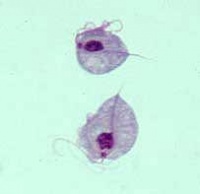Trichomonosis - Cattle
Also Known As Trichomoniasis — Tritrichomonosis — Tritrichomoniasis — Tritrichomonas foetus — Trichomonad abortion — Genital trichomonosis
Introduction
Bovine trichomonosis is a venereal disease caused by the flagellated prozoan Tritrichomonas foetus. Infection causes significant economic losses due to embryonic losses and abortion.
Tritrichomonas foetus is a notifiable disease to the World Organisation of Animal Health (OIE).
Trichomonosis is not considered zoonotic at present.
Signalment and Distribution
Trichomonosis is presumed to exist worldwide and shows no known breed predilection among cattle. Disease is most common among extensively grazing systems and is only present in herds using natural service. T foetus is extremely rare in exclusively artificially inseminated units, but will survive both freezing to -196⁰C and antibiotics used in semen extenders, so proper hygiene and extensive testing of donor bulls is imperative. Bull age is the most important risk factor for infection with infection much more likely in animals over 3 years old. This is due to the maturation of the crypts in the epithelium of the reproductive tract which the protozoa resides in in carrier animals. Older bulls are often chronic carriers for the remainder of their lives. Young bulls are much more likely to spontaneously clear infection and thus trophozoites are short-lived. No vectors are known to be involved in transmission of T foetus.
Clinical Signs
Bulls carry the infection asymptomatically. This provides a continuous source of infection which is transmitted during mating and direct contact. Transmission to females during mating is highly efficient and most will become infected after mating with an infected bull.
In females, early embryonic death by resorption and/or mummification between 21 and 100d gestation are the hallmarks of disease. Temporary or prolonged infertility is sometimes seen after abortion. The organism resides in the uterus and vagina.
Occasionally, post-coital pyometra may be seen, presenting as a vaginal discharge or flocculated uterine fluid on a routine fertility examination Infection is usually transient, lasting 8-18 weeks [1]
Less than 0.1% cows will become carriers. [2]
Diagnosis
A presumptive diagnosis is often made in high risk geographical areas where herd fertility performance is impaired. Failure of females to return to oestrus or maintain a pregnancy may prompt investigation, as may the presence of mucoid/purulent vaginal discharge or uterine fluid detected by palpation or ultrasound scanning, especially in conjunction with abortions on the same unit.
Microscopy and histology of preputial washes and vaginal swabs are commonly used:
On histology of penile and preputial epithelium, lymphoid aggregates may be identifiable. The inflammatory response in the female tract is similar and also non-specific, beginning neutrophilic and becoming a mixed infiltrate by the sixth week of infection. Infiltrates often surround the uterine glands in the stratum spongiosum and mast cells decline in number. By the twelfth week, cellularity has returned to normal.
Immunohistochemistry may reveal soluble antigen (SGA) within the epithelial cells, which is originally shed from the surface of T foetus. Parasite IgG and IgA can be found in vaginal secretions and serum complement fixation assays performed.
Treatment
Only bulls are usually treated.
Treatments of choice which are proven to be effective in vivo are acriflavine ointment applied topically to the glans penis, shaft and prepuce and nitromidazole compound given orally or topically in solution.
Note that nitrimadazoles are illegal in food animals in some countries and that precautions should be taken when applying acriflavine due to its staining and irritant nature.
Control
Testing and culling of bulls is imperative to eradication of Tritrichomonas foetus. Cows can also be vaccinated, using two subcutaneous injections 2-4 weeks apart. The course should finish 4 weeks prior to breeding. Vaccine is safe in pregnant cattle and can be used after exposure to reduce shedding. Implementation of artificial insemination where possible should replace natural service on infected farms.
References
Animal Health & Production Compendium. Trichomonosis datasheet, accessed 02/06/2010 @ http://www.cabi.org/ahpc/
